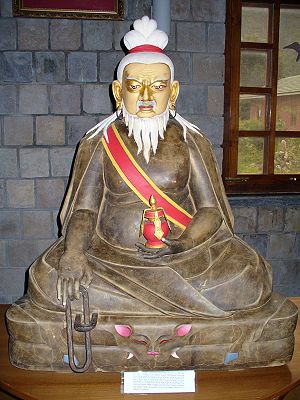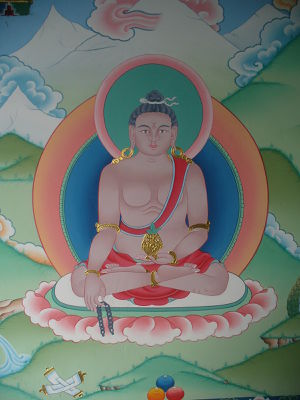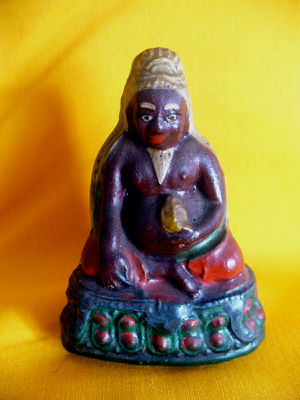Thangtong Gyalpo
Short biography of Thangtong Gyalpo
English
- Thangtong Gyalpo (1361-1485)
Thangtong Gyalpo, also known as Lungtong Nyönpa (lung stong smyon pa), Drubthob Chaksampa (lcags zam pa) and Tsöndrü Sangpo (brtson ’grus bzang po), was a great buddhist adept, physician, blacksmith, architect, and a pioneering civil engineer. He proclaimed himself, and was considered, the incarnation of the illustrous Dolpopa Sherab Gyaltsen (1292-1361), a leading Jonangpa master and formulator of the Shentong view of emptiness. He is said to have built 58 iron chain suspension bridges around Tibet and Bhutan, several of which are still in use today. He also designed and built several large stupas of unusual design including the great Kumbum Chörten at Chung Riwoche, Tibet; established the monastery of Derge Gönchen in Eastern Tibet; and is considered to be the father of Tibetan opera. He is associated with the Shangpa Kagyü, Nyingma and Sakya traditions of Tibetan Buddhism.
Thangtong Gyalpo was born at Ölpa Lhartse in upper Tsang in 1361. He is well known for his founding of Ache Lhamo, the Tibetan opera, and the numerous iron suspension bridges he built to ease travel and pilgrimage though the Himalayas. He established a song and dance troupe of seven sisters to raise the money needed to build these bridges. Thangtong Gyalpo opened the route through the land of Kongpo aborigines (the Lo) where he obtained iron for his bridges and rights of passage for Tibetan pilgrims to visit the holy places in Tsari to the southeast of Dakpo, near the Indian border. He is often shown in murals with long white hair and holding some chain links from his bridges. One of his iron chain suspension bridges, about 65 km from Lhasa, at Tsangpo, still existed in 1948, though it was in need of repairs and no longer used, the crossing being made by ferry. The old bridge was destroyed when a new one was opened about a hundred metres west of it. The old bridge was described as being of ancient design: "two thick chains are tied to heavy wooden beams underneath the pillars, from the top of which are suspended 12’ (4 m) ropes hung from the chains and support wooden boards a yard (1 m) long and a foot (30 cm) broad, allowing passage for one man. The bridge is a hundred paces long."
At the south end of the Tsangpo bridge was Thangtong Gyalpo’s main seat, Chaksam Chuwori and he lived in the Chaksam Labrang, the main building of the complex which included the assembly hall. The monastery had a hundred monks supported by the toll on the bridge. There was also a large stupa known as Tangtong’s Kumbum at the southern end of the bridge which eventually contained his relics, and a chapel at the top, containing an image of him. In 1433, Drubthob Thangtong Gyalpo and his disciples traveled to Phari in the Chumbi valley of Tibet, and from there to Paro Taktsang in Bhutan. According to his biography, while performing rituals of Vajrakila there, he had a vision of the assembly of the Eight Classes of Heruka (sgrub pa bka’ brgyad) meditational deities with Vajrakumara as the central figure.
It is said that a nine headed Naga spirit who was the guardian of the sacred place of Paro Taktsang, declared “your religious inheritance was concealed here by Orgyen Rinpoche, please make your discovery and reveal it”. Thereupon Drubchen Thangtong Gyalpo extracted a sacred scroll ten body lengths long from the cliff of Taktsang. The line of mountains where Taktsang is located is shaped like a black snake with its head in the middle of the Paro valley. On the nose of this snake the Drubthob constructed Dumtseg Lhakhang, a stupa shaped temple and pronounced that all diseases caused by evil spirits residing under the ground were suppressed and that the valley would be free from leprosy.
Tachog Lhakhang was established by Thangtong Gyalpo Arriving at a place called Phurdo, where he saw a five coloured rainbow upon which were seated Buddha Amitabha, Avalokiteśvara and Padmasambhava and declared that the place was as sacred as Potala mountain. At Tachog-gang, at the foot of the Phurdo mountains, he established Tachog Lhakhang temple and made sacred representations of the Buddha’s body, speech and mind. This temple, which is located opposite the road from Paro about 5km before Chudzom, is still maintained by the descendants of Drubthob Thangtong Gyalpo. From there he travelled to Drawang Tengchin where a rich man named Olag presented him three hundred and forty coins and turquoises and requested him to extract water. He did so and the water was sufficient to feed not only the people and cattle but also irrigate the fields. He then arrived at Gophog and told Lama Gyaltsen that he needed large quantities of iron to help him build links for compassionate purposes. Lama Gyaltsen answered that he would make available one hundred pieces of iron if the Drubthob could show him a proof of his attainment. The Drubthob told him to bring a boulder that was near the bridge which he split it into two by just pointing his finger. Within the stone they saw a live scorpion, the size of a thumb with innumerable new-born scorpions. The Drubthob prayed in Samadhi and the insects instantly disappeared in the form of a rainbow and he proclaimed that he had sent them to Sukhavati.
At Wundul Shari, he climed a steep mountain cliff, impossible to climb by the ordinary humans and stayed there for a month. He said that the cliff contained caves like Tashigomang and the place resembled Shambala in the north. However, he said, as ordinary people could not go there, he had made a door. When the people looked up they found an opening that did not exist earlier on the face of the cliff. Then he travelled to Wundul, Gyaldung and Langsamar, and upper and lower Ha region. He converted the offerings that he received into iron and renovated the iron bridge there. Then he went back to Dromo Dorje Gur in Tibet. From there, he travelled again to Thimphu and Thed valleys where he built an iron bridge at Bardrong. His journey then took him to Rued and Künsangling where Lama Thuchen presented him with two hundred and fifty pieces of iron. It is said that he also built the Chiwotokha Lhakhang (in Shar district) during this visit. He took all the offerings including the iron pieces to Paro, and turning himself into eighteen persons, he went into different villages such as Dolpöphu, Tsharlungnang, Dungkhar, Jiwu, Nyagbu and Lholingkha, and instructed eighteen blacksmiths to forge iron links.
After about three months, he had seven thousand iron links and many iron hammers and bars. At Kewangphug and other places, he built stupas to subdue the spirits of these areas. At Changlungkha Rawakha, Nyal Phagmodrong, Tachogang, Wundul Dronkar, Silung, Bagdrong, Binangkhache, Daglha, Gyirling and Nyishar, he conducted a lot of religious activities by providing image, scripture, stupa, iron bridges and established meditation centres. When he returned to Phari, the patrons and monks of the new monastery in Paro, had sent one thousand four hundred loads of iron (fifteen pieces of iron making a load), and seven hundred loads of ink, paper and other goods to Phari.
Drubchen Thangtong Gyalpo received the transmission of the entire Shangpa Kagyu lineage from Jangsem Jinpa Sangpo, who had received it himself from several masters of various lineages. Right after having received the transmission, he went into seclusion and practiced the Shangpa precepts. This resulted in a pure vision of the ḍākinī of primordial awareness (Niguma), and she accepted him as a direct disciple and granted him further transmissions and explanations. On several later occasions he had further visionary encounters with her and eventually composed many arrangements and instructions manuals, particularly on the “Six Doctrines of Niguma”.
Thangtong Gyalpo is said to have “passed away bodily, in the way of a sky-farer” in his 125th year at Riwoche.
Tibetan
༈ སྤྱན་རས་གཟིགས་དང་དཔལ་རྟ་མགྲིན་ཟུང་དུ་འཇུག་པའི་རྣམ་འཕྲུལ་གུ་རུ་པདྨ་མངལ་སྐྱེས་ཀྱི་ཚུལ་དུ་བྱོན་པ་གྲུབ་པའི་དབང་ཕྱུག་ཐང་སྟོང་རྒྱལ་པོ་ནི། རབ་བྱུང་དྲུག་པའི་ཤིང་གླང་ལོར་གཙང་སྟོད་འོལ་བ་ལྷ་རྩེར་སྐུའི་སྐྱེ་བ་བཟུང༌། ཡོངས་འཛིན་ལྔ་བརྒྱ་ལྷག་ཅིག་བསྟེན་ནས་གསན་བསམ་དཔག་ཏུ་མེད་པ་མཛད། རང་བྱུང་གི་གྲུབ་པའི་དབང་ཕྱུག་ཆེན་པོར་བཞུགས་ཀྱང་དགོས་པའི་དབང་གིས་ཀུན་སྤངས་དོན་ཡོད་རྒྱལ་མཚན་ལས་བྱང་གཏེར་ཡོངས་རྫོགས་དང༌༑ བླ་མ་རྡོ་རྗེ་གཞོན་ནུ་ལས་ཤངས་ཆོས་གསན་ཏེ། འདི་གཉིས་ལས་གྲུབ་པ་ཐོབ་པའི་ཚུལ་བསྟན། བརྟུལ་ཞུགས་ཀྱི་སྤྱོད་པས་འཛམ་གླིང་ཀུན་དང་གླིང་ཕྲན། ཁྱད་པར་རྔ་ཡབ་པདྨ་འོད་སོགས་སུ་ཕེབས་ནས་གུ་རུ་རིན་པོ་ཆེ་སོགས་གྲུབ་ཐོབ་དཔག་མེད་ལས་ཆོས་གསན། མཁའ་འགྲོ་དང་ཆོས་སྐྱོང་རྣམས་ཀྱིས་ཞབས་སྤྱི་བོར་བླངས། བོད་ལ་མཐའ་དམག་ཟློག་པའི་ས་གནད་ཀྱི་མེ་བཙའི་ལྷ་ཁང་མང་དུ་བཞེངས། ལྷ་འདྲེ་གདུག་པ་ཅན་ཐམས་ཅད་དམ་ལ་བཏགས། བསམ་ཡས་མཆིམས་ཕུ་ནས་ཚེ་སྒྲུབ་འཆི་མེད་དཔལ་སྟེར་སོགས་ཤོག་དྲིལ་ལྔ༌། གྲམ་པ་རྒྱངས་ནས་ཐུགས་སྒྲུབ་ཡང་གསང་བླ་མེད། སྒྲུབ་མཚོ་པདྨ་གླིང་ནས་མན་ངག་རིན་ཆེན་གཏེར་སྤུངས། མོན་སྤ་གྲོ་སྟག་ཚང་ནས་མདོ་རྒྱུད་ཐམས་ཅད་ཀྱི་ཟབ་གནད་ཕྱོགས་གཅིག་ཏུ་དྲིལ་བའི་ཤོག་དྲིལ་འདོམ་བཅུ་ཡོད་པ་ཞིག་དང༌། ཙཱ་རི་གསང་སྔགས་ཕོ་བྲང་ནས་ཟབ་ཆོས་ཐུགས་གཏེར་སྐོར། ཙཱ་རི་ཟིལ་ཆེན་ཕུག་ནས་གྲུབ་ཆེན་ཉིད་ཀྱི་ལུང་བསྟན་གསལ་བའི་སྒྲོན་མེ་དང་ཞིང་སྐྱོང་གི་སྒྲུབ་ཐབས་སོགས་ཟབ་གཏེར་མང་དུ་སྤྱན་དྲངས་ཤིང་གཏེར་ཁ་མང་པོ་ཕར་ལའང་སྦས། རྒྱ་གར་ཀ་མ་ཏར་སྡིག་སྤྱོད་མུ་སྟེགས་རྒྱལ་པོ་དང༌། བོད་ཡུལ་གྱི་མཐའི་ཀླ་ཀློ་རྣམས་བཏུལ་ནས་ཆོས་ལ་བཙུད་པ་སོགས་རྫུ་འཕྲུལ་གྱི་བཀོད་པ་ཚད་ལས་འདས། སྐུ་གསུང་ཐུགས་རྟེན་བློས་མི་འཁྱུད་ཅིང་གྲངས་ལས་འདས་པ་བཞེངས། ལྕགས་ཟམ་ལྔ་བཅུ་རྩ་བརྒྱད། གྲུ་ཤན་བརྒྱ་དང་བཅོ་བརྒྱད་བཙུགས་པ་སོགས་བསམ་གྱིས་མི་ཁྱབ་པའི་མཛད་པ་ཡོངས་སུ་གྲགས་པ་ལྟར་ལ། ཐ་ན་དེ་དག་གིས་སྐབས་དགེ་བསྐུལ་གྱི་ཆ་རྐྱེན་དུ་མཛད་པའི་སྔོན་གྱི་བྱང་སེམས་ཆོས་རྒྱལ་སོགས་ཀྱི་རྣམ་ཐར་ཟློས་གར་གྱི་ལམ་ནས་སྟོན་པ་དེང་སང་ཨ་ཅེ་ལྷ་མོར་གྲགས་པའི་འཁྲབ་གཞུང་གི་རྒྱུན་འདི་ཙམ་ཡང་མཐོང་བ་དོན་ལྡན་གྱི་ཕྲིན་ལས་ངོ་མཚར་ཕུལ་དུ་གྱུར༑ མཐར་དགུང་ལོ་བརྒྱ་དང་ཉེར་ལྔ་བཞེས་པའི་སྐབས་སྐུ་དངོས་ཀྱིས་མཁའ་སྤྱོད་དུ་གཤེགས་པའི་ཚེ་ཐུགས་སྲས་ཉི་མ་བཟང་པོས་གདུང་དབྱངས་མཛད་པས་སླར་ཕེབས་ཏེ་ཞལ་ཆེམས་རྒྱས་པར་སྩལ་ནས་དཔལ་རི་བོ་ཆེ་རུ་གཤེགས་པའི་ཚུལ་བསྟན། མངའ་རིས་གྲུབ་ཆེན་ཚུལ་ཁྲིམས་བཟང་པོ་ཞེས་དགུང་ལོ་བརྒྱ་དང་སུམ་ཅུར་བཞུགས་ནས་མཐར་སྐུ་ལུས་འོད་ཕུང་དུ་གཤེགས་པ་དེ་དང༌། མདོ་ཁམས་སུ་གྲུབ་ཐོབ་ཕྱར་ཐུལ་ཅན་ཅེས་གྲགས་པ་རྣམས་ཀྱང་གྲུབ་ཆེན་འདི་ཉིད་ཀྱི་སྐུའི་བཀོད་པ་ཡིན་པར་སྣང་ཞིང༌། ལས་ཅན་རྣམས་ལ་ད་ལྟའི་བར་ཡེ་ཤེས་ཀྱིས་སྐུས་རྗེས་སུ་བཟུང་བ་མང་དུ་བྱུང༌། སློབ་ཚོགས་མཐའ་ཡས་པ་བྱུང་ཞིང་ཁྱད་པར་གྲུབ་ཆེན་ཉིད་འཆི་མེད་ཚེའི་རིག་འཛིན་བརྙེས་པའི་རྟེན་འབྲེལ་གྱིས་བརྒྱུད་འཛིན་སྐུ་ཚེའི་དངོས་གྲུབ་བརྙེས་པ་མང་དུ་བྱོན། ཟབ་ཆོས་ཐང་སྟོང་སྙན་བརྒྱུད་ཆེན་མོའི་རྒྱུན་བཞུགས་པར་སྣང་ཞིང་ཚེ་སྒྲུབ་འཆི་མེད་དཔལ་སྟེར་ནི་གསར་རྙིང་ཀུན་ལ་ཁྱབ། ཕྱིས་འདིར་རྗེ་པདྨ་འོད་གསལ་མདོ་སྔགས་གླིང་པར་ཡེ་ཤེས་ཀྱི་སྐུས་ཡང་ཡང་རྗེས་སུ་བཟུང་ཞིང་བྱིན་གྱིས་བརླབས་པ་ལ་བརྟེན་དགོངས་པའི་ཀློང་ནས་བརྡོལ་བའི་ཐུགས་གཏེར་གྲུབ་ཐོབ་སྙིང་ཏིག་རྩ་བ་བླ་སྒྲུབ་ཀྱི་སྐོར་བསྐྱེད་རྫོགས་ཟབ་རྒྱས་དང༌། ཡན་ལག་རྒྱུད་སྡེ་སྒྱུ་འཕྲུལ་གྱི་ལམ་དང་མཐུན་པའི་སྒྲུབ་ཐབས་སྐོར་ལྔ། སྒྲུབ་སྡེ་བཀའ་བརྒྱད་ཀྱི་རྒྱུད་ལུང་མན་ངག་སྙིང་པོར་དྲིལ་བ་སོགས་ཆོས་སྡེ་ངོ་མཚར་ཅན་གཏན་ལ་ཕབ་པ་རིན་ཆེན་གཏེར་མཛོད་དུ་བཞུགས་སོ། །བདུད་འཇོམས་འཇིགས་བྲལ་ཡེ་ཤེས་རྡོ་རྗེས་གསུངས་སོ།།
Primary Teachers
- Niguma
- Jangsem Jinpa Sangpo (byang sems sbyin pa bzang po)
- Khangapa Paljor Sherab (bka' lnga pa dpal 'byor shes rab)
- Lama Nyima Senge (bla ma nyi ma seng ge)
- Togden Dragpa Tsenchen (rtogs ldan grags pa'i mtshan can)
Students
- Doringpa Kunzang Chökyi Nyima (rdo ring pa kun bzang chos kyi nyi ma) [1449-1524] aka Doringpa Kunpang Chenpo
- Tenzin Chöje Nyima Zangpo (bstan 'dzin chos rje nyi ma bzang po) - son
- Mangkharwa Lodrö Gyaltsen (mang mkhar ba brgyud 'dzin blo gros rgyal mtshan)
- Togden Shepa Rangdrol (rtogs ldan shes pa rang grol)
- Gyalse Osel (rgyal sras 'od gsal klong dbyangs)
- Jangsem Kunga Nyima (byang sems kun dga' nyi ma)
- Chökyi Drönma (chos kyi sgron ma, 1434-1467/8)
Primary Lineages
- Shangpa Kagyu / shangs pa bka' brgyud (thang lugs)
- Nyingma, Northern Treasures (byang gter)
- Sakya
- Chö yul (gcod yul)
Alternate Names
Incarnation Lineages
Drubthop Chakzampa Tulkus
- Thangthong Gyalpo [1361?-1485]
- Char Thukchan
- Ja-Kangpa
- Jatangpa Nering Sonam
- Jatangpa Nering Chodpa
- Nering Jatangpa
- Jatangpa Phuntshog [1738-1790]
- Jatangpa Yontenpal
- Jatangpa Oewapal
- Ngedon Nyingpo
- Khyentse Wangpo
- Dewai Dorje
- Jatangpa Zhabkar Tshogdrug Rangdrol
- Jatangpa Ri-ul Lama
- Jatangpa Sulmang Chodgyan
- Drupai Wangchuk Chenpo Rikey Jadral
- Ngawang Thinley Lhundrub b. 1990
Monastaries associated with the Lineage of Thangtong Gyalpo
Drupthop Lhakhang, Thimphu, Bhutan
The Thangtong Dewachen nunnery or Drupthop Lhakhang was founded in 1976 by the 16th Drubthop Rinpoche Rikey Jadrel, considered an emanation of Thangtong Gyalpo, with the aim of promoting Buddhism in general and lineage of Tangtong Gyalpo in particular. Today the nunnery houses sixty nuns engaged in Buddhist study and practice. The nunnery mainly follows the Shangpa lineage of Thangtong Gyalpo and the Jangter and Abham Tercho lineages of the Nyingma School.
Other Reference Sources
- See also: thang rgyal snyan rgyud - Oral Transmission of Thangtong Gyalpo (in volume one of Chögyal Namkhai Norbu's klong gsal teachings). JV; grub thob thugs tig Heart Essence of the Great Siddha.
Tibetan (chos skad)
- Author: shes rab dpal ldan; Title: rje grub thob chen po lcags zam pa'i rnam par thar pa ngo tshar rgya mtsho [ in The Collected Works (gsung 'bum) of Thang-stong rgyal-po Volume 1]
- Author: ; Title: bla ma thang stong rgyal po'i rnam thar gsal ba'i sgron me [ in The Collected Works (gsung 'bum) of Thang-stong rgyal-po Volume 2]
- Author: lo chen 'gyur med bde chen [1540-1615] ; Title:grub pa'i dbang phyug chen po lcags zam pa thang ston rgyal po'i rnam thar no mtshar kun gsal nor bu'i me long gsar pa TBRC W23929
English
- Author: Stearns, Cyrus; Title: King of The Empty Plan: The Tibetan Iron Bridge Builder Tangtong Gyalpo [ISBN 978-1559392754]
- Author: Gerner, Manfred; Title: Chakzampa Thangtong Gyalpo [ISBN 99936-14-39-4] - Download PDF version from the Centre for Bhutan Studies


